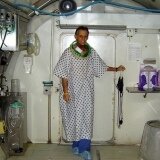Blast Injury and Hyperbaric Oxygenation
Featured article. Page 3.
Acute Brain and Cardio-Respiratory Dysfunction After Blast/Blunt Injuries: The Life-Preserving Effects of Hyperbaric Oxygenation
Gennady G. Rogatsky and Avraham Mayevsky
The Mina & Everard Goodman Faculty of Life Sciences and the Leslie and Susan Gonda Multidisciplinary Brain Research Center, Bar-Ilan University, Ramat-Gan 52900, Israel
2. Pathophysiological Changes in the Brain
The brain is clearly vulnerable to both secondary and tertiary blast injury. There is still an unresolved controversy whether primary blast forces directly injure the brain. Shear and stress waves from the primary blast could potentially cause traumatic brain injury (TBI) directly, e.g. concussion, hemorrhage, edema, diffuse axonal injury.209 The primary blast can also cause the formation of gas emboli, leading to infarction.86
Clinical data for brain injury due to primary blast forces are quite limited. Most studies involve war-related injuries, although blast-related injuries due to air blast and firecrackers have also been reported. In a battlefield situation, it can be extremely difficult to confidently identify cases in which only primary blast injury is present. In addition, neuro-pathological information was only occasionally available.209 Almost a century of medical literature provides only a few cases in which brain injuries are likely to have resulted from primary blast forces.52,97,126,146,150,208
Reported neuropathological changes have included small hemorrhages within white matter, chromatolytic changes in neurons (due to degeneration of Nissl bodies, an indication of neuronal damage), diffuse brain injury and subdural hemorrhage. Mott wrote in detail about a few cases where primary blast was the proposed cause of death.146 Although, he was aware that the available methods for examining the brain were rather limited.209 Nonetheless, many findings described by Mott have been supported by experimental studies conducted in the subsequent years.119,120,141,165
Another group (utilizing rabbits and rats) studied the brain effects of primary blast exposure (delivered by a shock tube) sufficient to cause moderate lung injury.37-39 In some cases, the effect of exposing the whole body was compared to exposing only the thoracic region (with the head protected by a steel plate).39 Both types of blast exposure resulted in ultra-structural evidence of neuronal injury in the examined areas (hippocampus, brainstem reticular formation). The authors noted that the pattern of neuronal abnormalities is similar to those seen in diffuse axonal injury. Biochemical changes indicative of oxidative stress were also present. The degree of neuronal damage correlated with impaired performance on an active avoidance task.
Other groups have reported the effects of exposure to blast forces at levels designated to be below the threshold for induction of macroscopic lung injury.187, 14 One group demonstrated a change in the localization of neuro-filament protein staining from axons and dendrites to the cell body in cortical neurons following the exposure (in rats).187 The authors noted that these changes likely result from disturbed anterograde axonal transport.
Another group used open air exposure (utilizing pigs oriented with their hind quarters closest to the explosive) just below the threshold for induction of macroscopic lung injury.14 Depression of electro-encephalographic (EEG) activity was reported in half of the animals immediately following the blast exposure. EEG amplitude was reduced by about 50% for a short time (5-15 sec).
More severe injury to the brain and spinal cord usually occurs under secondary and tertiary effects of serious blast head injury, which is the most common cause of death in terrorist bombings.65,78,132,213 Experimental studies in rats that sustained a large energy blast, have demonstrated hemorrhage into the ventricles and into the pia, but none into the brain substance itself.86 Other studies in rats demonstrated hypertrophy of microglia cells, a characteristic feature of neural degeneration, evident in the superficial zones of the cerebral and cerebellar cortex, between day 1 and day 14 post-injury.120
While clinical and experimental evidence exists for directly induced damage to the nervous system by the shock wave, more is known about the effects of air embolism in cerebral vessels. This is probably a more significant mechanism of injury. Air gains access to the circulation via alveolar-venous fistulae secondary to pulmonary blast injury and has been considered to be one of the principal causes of immediate and early death due to primary blast injury.203
Here we should again point to the works of Cernak et al., whose laboratory studies following blast over-pressure have shown the emergence and development of ultra-structural manifestations: the swelling of neurons, glial reaction and myelin debris in the hippocampus, while the heads of animals were not directly subjected to trauma.39 According to these authors, this was due to the development of post-traumatic oxidative stress.37,39 Cognitive impairment and biochemical changes in the hippocampus were significantly correlated with blast injury severity.
More severe and life-threatening functional brain impairment occurs under secondary and/or tertiary blast injury. Experimental studies of this problem in rats (using severe fluid percussion brain injury model) showed that multiple cardio-vascular abnormalities, including sub-arachnoid hemorrhage, focal cerebral platelet accumulation, and severe ischemia (hypo-perfusion, local CBF<0.25 ml/g/min), are important early events in the pathogenesis of cortical contusion after TBI.19,67 66,129,236 The work of Hlatky et al.99 demonstrated that in patients with global CBF<18 ml/100 g/min, intra-cranial hypertension plays a major causative role in the reduction of CBF.
Mortality in the patients with CBF<18 was 90%, while in those with CBF>18 it was 19%. This result, as well as the results of many other studies, may evidence the crucial role of changes in the intra-cranial pressure in the pathogenesis of traumatized brain.1,5,55,74,96,101,114,129,137,138,189,214 As previous studies have shown, the basic mechanism of acute post-traumatic intra-cranial hypertension is the increase in the permeability of the brain-blood barrier (BBB) and cytotoxic selectivity,130 which lead to cerebral edema during the very first hours after trauma.18,102 In the majority of these works, critical elevation in the ICP represents the leading cause of morbidity and mortality under severe traumatic brain injury.
At the same time, we would like to point out the pronounced variability of the ICP level that is considered to be predictive of high-probability death outcome. The level, as it is given by various authors, equates no less than 15 mm Hg,154 20 mm Hg,138,163 30 mm Hg167 and even 35 mm Hg.40 In our recent paper, we presented original data, obtained in experiments on rats, indicating that under traumatic brain injury, for prognostic purposes, it is important to know not only (and not primarily) the absolute value of ICP (as a “basic” parameter), but also the rate of its increase. Under continuous ICP monitoring in the initial post-traumatic period, the rate of ICP increase in animals of the fatality group was approximately 2 times higher than in the group with a favorable course. The average estimates for this entire period were 2.24 and 0.95 mmHg per 30 min for the corresponding groups.180
Bearing in mind the possibility that, under secondary and/or tertiary blast injury, there can be marked disturbances in CBF and progressive increase in ICP, as well as the above-mentioned system impairments of the circulatory-respiratory function in cases of severe traumas – it is always important to consider the degree of impairment of oxygen supply to the brain. This question becomes particularly important when considering victims’ resuscitation after especially severe traumas.
In this regard, when investigating the pathophysiological mechanisms of the development of critical conditions after secondary and tertiary blast injury, it is important to note the results obtained by Moss and Stein,143-145 de Oliveira and Antonio.63,64 In the experimental studies on dogs and rats, reconstituting various modes of cellular oxygen deprivation and brain dysfunction (hemorrhagic shock, cerebral hypoxemic perfusion) – evidence has been obtained for a central-neurogenic etiology of the respiratory distress syndrome (RDS).
Blockade of neurogenic effects on the lungs (either chirurgical or pharmacological) evidently prevented the development of the above-said complex of the said pulmonary pathology symptoms.143-145 Experiments on rats showed that adrenalectomy, adrenal demedullation and denervation, alpha-adrenergic blockade, and cathecolamine (CA) depletion reduced ARDS severity, whereas beta-adrenergic blocking and CA uptake I inhibition resulted in a potentiated aspect.63,64
It has been shown that the decrease in cerebral metabolism is a typical complication in the most severely injured pateints groups, where it occurs in a third to half of the patients.149,152 Experimental models of fluid percussion brain injury in rats have shown that focal and diffuse metabolic depression develops already in the early period after moderate TBI.238
The data presented above lead to the conclusion that oxygen supply to the brain is often insufficient after traumatic brain injury and this results in deceased energy production (ATP) with consequent metabolic depression and neuronal cell death.228 It is obviously important to restore oxygen delivery after TBI. However, in accordance to modern views, increasing oxygen delivery alone may not improve ATP production if patients’ mitochondria (the source of ATP) are injured.227,228 The level of mitochondrial activity, in particular the mitochondrial failure, is a crucial factor in the pathogenesis of acute damage following severe traumatic brain injury. As such, in the past decades, it is increasingly becoming the subject of intensive research.42,227,228,239
At the present time, data on the pathogenesis of the early stage of brain trauma are quite insufficient, their scope and profundity lagging behind the present-day urgency. One of the major reasons for this is the methodological difficulty of obtaining information in vivo from the brain surface directly subjected to severe mechanical trauma. The extensive experimental data recently obtained in our laboratory using multi-parametric assembly (MPA) brain monitoring in rats after TBI, demonstrate that intracranial pressure (ICP) (along with CBF and electroencephalogram) remain, during the entire observation period, the most informative and reliable indicators of the conditions under investigation.
Beside the original reports investigating several specific mechanisms of post-traumatic cycle development under cortical spreading depression and intracranial hypertension183 – the said technique yielded important original data regarding cerebral hemodynamics, ionic, metabolic and electrical activity in rats under fluid percussion brain injury (FPBI) in various degrees of severity.
Figure 2 demonstrates typical changes in brain parameters in rats after severe FPBI. It has been demonstrated that the most prominent effect of TBI at all degrees (mild, moderate and severe) was a significant increase in the ICP (p<0.01). When examining the effect of trauma severity, it was found that at any given time after the trauma the ICP was the largest in the severe trauma group, intermediate in the moderate trauma group and lowest in the mild trauma group (p<0.05). TBI caused a rapid decrease in CBF at all levels of trauma (p<0.05).
The decrease in CBF was maintained for 60 minutes. Extra-cellular K+ was elevated in the severe injury group, during the first 120 minutes. Extra-cellular pH and the DC steady potential demonstrated a significant decrease during the first 60 minutes following all the three levels of trauma (p<0.05). The averaged number of spreading depression (SD) waves per hour was maximal at 2-3 hours post trauma and usually appeared after seizures.
ECoG was depressed proportionally to the injury level, cerebral blood volume decreased most in the moderate trauma group, intermediately in the severe trauma group, and least in the mild trauma group (p<0.05). NADH levels and extracellular Ca2+ increased slightly during the first hour, and then decreased (not significantly).129
Under maximally severe trauma, the characteristic constellation of features registered by the MPA, presented an irreversible tendency toward decreasing CBF and pH, a rise in CBV, an increase in the level of mitochondrial NADH (corrected fluorescence), K+ and ICP, taking place concomitantly with ECoG depression and (or) increase of epileptic-form cortical activity, and an increase in the number of cycles of cortical spreading depression, progressing until the moment of breath-stop (Fig. 1). This combination of traits was identified by the authors as acute progressive development of hypoxia and mitochondrial dysfunction of traumatized brain tissue183 (Fig. 3).










